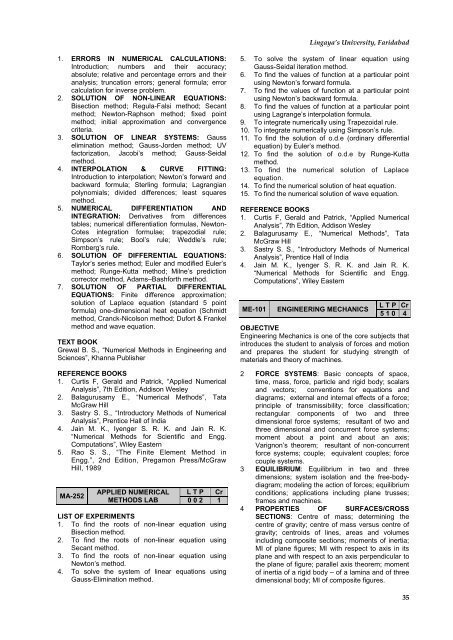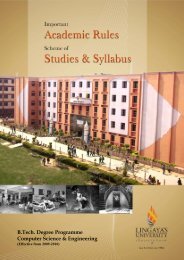Electrical and Electronics - Lingaya's University
Electrical and Electronics - Lingaya's University
Electrical and Electronics - Lingaya's University
You also want an ePaper? Increase the reach of your titles
YUMPU automatically turns print PDFs into web optimized ePapers that Google loves.
Lingaya’s <strong>University</strong>, Faridabad1. ERRORS IN NUMERICAL CALCULATIONS:Introduction; numbers <strong>and</strong> their accuracy;absolute; relative <strong>and</strong> percentage errors <strong>and</strong> theiranalysis; truncation errors; general formula; errorcalculation for inverse problem.2. SOLUTION OF NON-LINEAR EQUATIONS:Bisection method; Regula-Falsi method; Secantmethod; Newton-Raphson method; fixed pointmethod; initial approximation <strong>and</strong> convergencecriteria.3. SOLUTION OF LINEAR SYSTEMS: Gausselimination method; Gauss-Jorden method; UVfactorization, Jacobi‘s method; Gauss-Seidalmethod.4. INTERPOLATION & CURVE FITTING:Introduction to interpolation; Newton‘s forward <strong>and</strong>backward formula; Sterling formula; Lagrangianpolynomials; divided differences; least squaresmethod.5. NUMERICAL DIFFERENTIATION ANDINTEGRATION: Derivatives from differencestables; numerical differentiation formulas, Newton-Cotes integration formulae; trapezodial rule;Simpson‘s rule; Bool‘s rule; Weddle‘s rule;Romberg‘s rule.6. SOLUTION OF DIFFERENTIAL EQUATIONS:Taylor‘s series method; Euler <strong>and</strong> modified Euler‘smethod; Runge-Kutta method; Milne‘s predictioncorrector method, Adams–Bashforth method.7. SOLUTION OF PARTIAL DIFFERENTIALEQUATIONS: Finite difference approximation;solution of Laplace equation (st<strong>and</strong>ard 5 pointformula) one-dimensional heat equation (Schmidtmethod, Cranck-Nicolson method; Dufort & Frankelmethod <strong>and</strong> wave equation.TEXT BOOKGrewal B. S., ―Numerical Methods in Engineering <strong>and</strong>Sciences‖, Khanna PublisherREFERENCE BOOKS1. Curtis F, Gerald <strong>and</strong> Patrick, ―Applied NumericalAnalysis‖, 7th Edition, Addison Wesley2. Balagurusamy E., ―Numerical Methods‖, TataMcGraw Hill3. Sastry S. S., ―Introductory Methods of NumericalAnalysis‖, Prentice Hall of India4. Jain M. K., Iyenger S. R. K. <strong>and</strong> Jain R. K.―Numerical Methods for Scientific <strong>and</strong> Engg.Computations‖, Wiley Eastern5. Rao S. S., ―The Finite Element Method inEngg.‖, 2nd Edition, Pregamon Press/McGrawHill, 1989MA-252APPLIED NUMERICALMETHODS LABL T P Cr0 0 2 1LIST OF EXPERIMENTS1. To find the roots of non-linear equation usingBisection method.2. To find the roots of non-linear equation usingSecant method.3. To find the roots of non-linear equation usingNewton‘s method.4. To solve the system of linear equations usingGauss-Elimination method.5. To solve the system of linear equation usingGauss-Seidal iteration method.6. To find the values of function at a particular pointusing Newton‘s forward formula.7. To find the values of function at a particular pointusing Newton‘s backward formula.8. To find the values of function at a particular pointusing Lagrange‘s interpolation formula.9. To integrate numerically using Trapezoidal rule.10. To integrate numerically using Simpson‘s rule.11. To find the solution of o.d.e (ordinary differentialequation) by Euler‘s method.12. To find the solution of o.d.e by Runge-Kuttamethod.13. To find the numerical solution of Laplaceequation.14. To find the numerical solution of heat equation.15. To find the numerical solution of wave equation.REFERENCE BOOKS1. Curtis F, Gerald <strong>and</strong> Patrick, ―Applied NumericalAnalysis‖, 7th Edition, Addison Wesley2. Balagurusamy E., ―Numerical Methods‖, TataMcGraw Hill3. Sastry S. S., ―Introductory Methods of NumericalAnalysis‖, Prentice Hall of India4. Jain M. K., Iyenger S. R. K. <strong>and</strong> Jain R. K.―Numerical Methods for Scientific <strong>and</strong> Engg.Computations‖, Wiley EasternME-101ENGINEERING MECHANICSL T P Cr5 1 0 4OBJECTIVEEngineering Mechanics is one of the core subjects thatintroduces the student to analysis of forces <strong>and</strong> motion<strong>and</strong> prepares the student for studying strength ofmaterials <strong>and</strong> theory of machines.2 FORCE SYSTEMS: Basic concepts of space,time, mass, force, particle <strong>and</strong> rigid body; scalars<strong>and</strong> vectors; conventions for equations <strong>and</strong>diagrams; external <strong>and</strong> internal effects of a force;principle of transmissibility; force classification;rectangular components of two <strong>and</strong> threedimensional force systems; resultant of two <strong>and</strong>three dimensional <strong>and</strong> concurrent force systems;moment about a point <strong>and</strong> about an axis;Varignon‘s theorem; resultant of non-concurrentforce systems; couple; equivalent couples; forcecouple systems.3 EQUILIBRIUM: Equilibrium in two <strong>and</strong> threedimensions; system isolation <strong>and</strong> the free-bodydiagram;modeling the action of forces; equilibriumconditions; applications including plane trusses;frames <strong>and</strong> machines.4 PROPERTIES OF SURFACES/CROSSSECTIONS: Centre of mass; determining thecentre of gravity; centre of mass versus centre ofgravity; centroids of lines, areas <strong>and</strong> volumesincluding composite sections; moments of inertia;MI of plane figures; MI with respect to axis in itsplane <strong>and</strong> with respect to an axis perpendicular tothe plane of figure; parallel axis theorem; momentof inertia of a rigid body – of a lamina <strong>and</strong> of threedimensional body; MI of composite figures.35
















